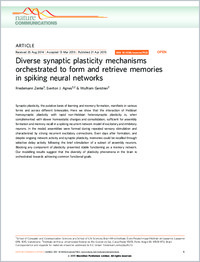Diverse synaptic plasticity mechanisms orchestrated to form and retrieve memories in spiking neural networks.
- Zenke F School of Computer and Communication Sciences and School of Life Sciences, Brain-Mind Institute, École Polytechnique Fédérale de Lausanne, Lausanne EPFL 1015, Switzerland.
- Agnes EJ School of Computer and Communication Sciences and School of Life Sciences, Brain-Mind Institute, École Polytechnique Fédérale de Lausanne, Lausanne EPFL 1015, Switzerland.
- Gerstner W School of Computer and Communication Sciences and School of Life Sciences, Brain-Mind Institute, École Polytechnique Fédérale de Lausanne, Lausanne EPFL 1015, Switzerland.
- 2015-04-22
Published in:
- Nature communications. - 2015
English
Synaptic plasticity, the putative basis of learning and memory formation, manifests in various forms and across different timescales. Here we show that the interaction of Hebbian homosynaptic plasticity with rapid non-Hebbian heterosynaptic plasticity is, when complemented with slower homeostatic changes and consolidation, sufficient for assembly formation and memory recall in a spiking recurrent network model of excitatory and inhibitory neurons. In the model, assemblies were formed during repeated sensory stimulation and characterized by strong recurrent excitatory connections. Even days after formation, and despite ongoing network activity and synaptic plasticity, memories could be recalled through selective delay activity following the brief stimulation of a subset of assembly neurons. Blocking any component of plasticity prevented stable functioning as a memory network. Our modelling results suggest that the diversity of plasticity phenomena in the brain is orchestrated towards achieving common functional goals.
- Language
-
- English
- Open access status
- gold
- Identifiers
-
- DOI 10.1038/ncomms7922
- PMID 25897632
- Persistent URL
- https://sonar.ch/global/documents/102502
Statistics
Document views: 7
File downloads:
- fulltext.pdf: 0
